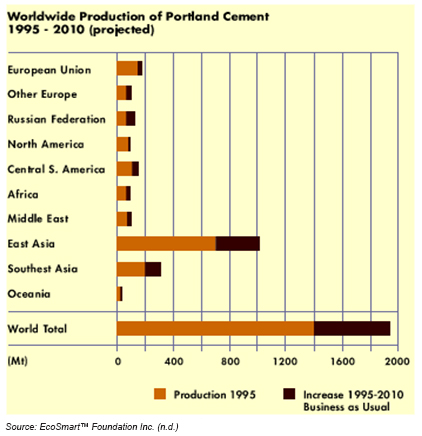Why is this issue important?
Next to water, concrete is the second-most consumed substance on earth; on average, each person uses nearly three tonnes a year. Portland cement, the major component of concrete, is used to bind the materials that make up concrete. The concrete industry uses about 1.6 billion tonnes of portland cement and produces some 12 billion tonnes of concrete a year.
The industry has a large ecological footprint: it uses significant amounts of natural resources such as limestone and sand, and depending on the variety and process, requires 60-130 kg of fuel oil and 110 kWh of electricity to produce each tonne of cement. In addition, the cement industry is second only to power generation in the production of CO2. Producing one tonne of portland cement releases roughly one tonne of CO2 to the atmosphere, and sometimes much more, and the cement industry accounts for 7-8 per cent of the planet’s human-produced CO2 emissions. Half of it comes from producing clinker (the incombustible remains of coal combustion), 40 per cent from burning fuel and 10 per cent from electricity use and transportation (Mahasenan and others 2003, WBCSD 2005).
|
 |
Although cement making has become more efficient and the amount of greenhouse gas the industry emits has declined, further reductions will be diffi cult since processing limestone produces CO2 and demand is increasing—within the next 30 years, worldwide demand for concrete is expected to double. Thus, it is critical that ways are found to reduce the concrete industry’s environmental impact, especially its large contribution to global warming.
What are the findings and implications?
|
Much recent research has been conducted to investigate the potential for reducing greenhouse gas
(GHG) emissions from the cement industry. Most of it has focused on using alternative materials to replace
the maximum amount of cement used in concrete production, which would create a more sustainable
process and product. Some of the most commonly used alternatives are waste products from industrial
processes, such as fly ash, a by-product of coal-fired power plants; cement-kiln dust; volcanic ash; ground,
granulated blast-furnace slag; rice-husk ash; and silica fume. Studies have shown that when blended
in the right proportion and activated properly, using supplementary cementing materials can reduce
emissions, energy use and resource consumption while still producing cement with robust strength and
performance. In addition, there is the environmental benefit of waste reduction (Shah and others 2004).
|
The addition of such alternative materials to concrete often gives the product other benefits: they are
recyclable, durable and need less maintenance and the product is often more economical and has reduced
permeability and increased strength.
Another promising technique to reduce the industry’s GHG emissions involves capturing the CO2 used in the
cement-making process to make other products, such as carbonates, bicarbonates, solids and liquids that
capture the CO2 molecule. One example is sending the CO2 emissions through seawater to create a carbonate
material that can be used to create concrete, thereby securing the gas permanently inside the building
material (Biello 2007). Emerging technologies that reduce the environmental impact of cement production
have a significant role to play in mitigating climate change. UNEP’s Sustainable Buildings and Climate
Initiative recognizes this and supports the wide adoption of sustainable building practices (UNEPSBCI
2010). More policy and market incentives to support research and development of supplementary cementing materials and carbon capture and storage
in concrete are needed.
References
Biello, D. (2007). Cement from CO2: A Concrete Cure for Global Warming? Scientific American, 7 August. http://www.scientificamerican.com (Accessed pn August 21, 2010)
EcoSmartTM Foundation Inc. (n.d.). Environmental Impact: Cement Production and the CO2 Challenge. Vancouver B.C http://www.ecosmartconcrete.com/ (Accessed on August 21, 2010)
Mahasenan, N., Smith, S., Humphreys, K., Kaya, Y. (2003). The cement industry and global climate change: current and potential future cement industry CO2 emissions. In Greenhouse Gas Control Technologies - 6th International Conference. Oxford: Pergamon, 995-1000.
Shah, S., Wang, K. (2004). Development of "green" cement for sustainable concrete using cement kiln dust and fl y ash. In Proceedings of the International Workshop on Sustainable Development and Concrete Technology, Beijing, China, 20-21 May 2004. Edited by Kejin Wang. Ames, IA: Center for Transportation Research and Education, Iowa State University
UNEP-SBCI. (2010). Sustainable Buildings and Climate Initiative. http://www.unep.org/sbci/index.asp (Accessed on 27 October 2010)
WBCSD. (2005). The Cement Sustainability Initiative: Progress Report. World Business Council for Sustainable Development. http://www.wbcsd.org/ (Accessed on August 21, 2010)





